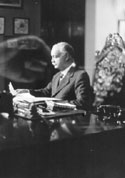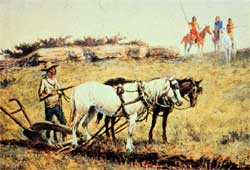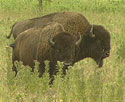| Final Years in Kansas 1861-1873 |

Kaw Mission
Exhibit |
During the American Civil War at least
seventy Kaw warriors served in the Union army as members of
Company L, Ninth Kansas Cavalry. Read More...
Following the war an increased
influx of settlers into the region increased pressure on the Kaw to withdraw entirely from the state.
|
The
Kaw were able
to hang on to the Neosho Valley Reservation longer than many
other Kansas tribes because of infighting among white factions
coveting the Kaws’ diminished reserve. At least four fairly
distinct groups: local merchants - speculators, absentee land
jobbers, squatter farmers, and railroad interests fought each
other over which group would prevail in acquiring possession of
the Kaw land.
|
|
|
In the meantime in August 1868,
a conflict took place on the Kaw Reservation between the Cheyenne
warriors and Kaw warriors. The Cheyennes had approached Council
Grove from the west, seeking revenge for a bloody encounter with
the Kaws the previous winter. The Cheyennes caused panic among
Council Grove whites. Women and children fled to the Kaw Mission
for protection.
|
 |
The Cheyennes engaged the
Kaws in a largely
bloodless skirmish about four miles southeast of Council Grove.
After a few hours of trading insults and staying out of each
other’s firing range, the mounted Cheyennes withdrew with one
minor casualty. White men had made a social occasion of the
skirmish, watching the battle from nearby hilltops.
|
|
One
of the witnesses of the "battle" was eight-year-old
Charles Curtis. Charles had come to live with his maternal
grandmother on the Council Grove Reservation in 1866. One-eighth
Kaw, little Charlie returned to Topeka soon after the Cheyenne
skirmish. He went on to a successful political career both on
the state and national levels.
In 1929 he was elected to the
vice-presidency of the United States on the Republican ticket
headed by Herbert Hoover. He served as vice-president from 1929
to 1933, the only person of Indian descent ever to occupy either
the office of vice-president or president in U.S. history.
|
 |
|
In
1869 the Missouri, Kansas, and Texas Railroad (KATY) was
constructed through the diminished Kaw Reserve. The
reservation boundaries became increasingly porous as land-hungry
whites squatted illegally on Kaw land in the early 1870's. These
"settlers" cut down timber, broke the virgin prairie
sod, turned their livestock loose to roam the reservation. The
Indians protested, but to no avail.
|
 |
In June 1872 U.S. Secretary of Interior,
Columbus Delano came to Council Grove to tell the Kaws that
they must submit to relocating to a new reservation in Indian
territory (modern Oklahoma). Most of the Kaw chiefs protested
vigorously. Chief Al-le-ga-wa-ho said to Delano: "You
whites treat us Kon-zey like a flock of turkeys; you chase us
from one stream, then to another stream - soon you will chase us
over the mountains and into the ocean."
|
|
But Delano insisted that the
Kaw go. The
following spring the government gave the Kaw permission to
travel to Western Kansas for one last buffalo hunt. This hunt
was successful; then in June 1873, the six hundred remaining Kaws made a seventeen-day journey south to the new reservation
in Indian Territory.
|
 |
 |
"The
matter was not left to a vote of the tribe. After
hearing the speaker of the Indians in this
council attended by possibly twenty or thirty of the leading
men, Secretary Delano again spoke and this time gave no chance
for argument. He told them emphatically, it was the policy of
the President to remove the tribes in Kansas to the (then)
Indian territory and that they must move. I heard no further
protest after this speech - except the wailing of women at the
graves of the dead, night and morning for months before the
removal."
Interpreter Addison
Stubbs’ description of the 1872 meeting between Secretary of
the Interior Delano and the Kaw chiefs.
|
| |


